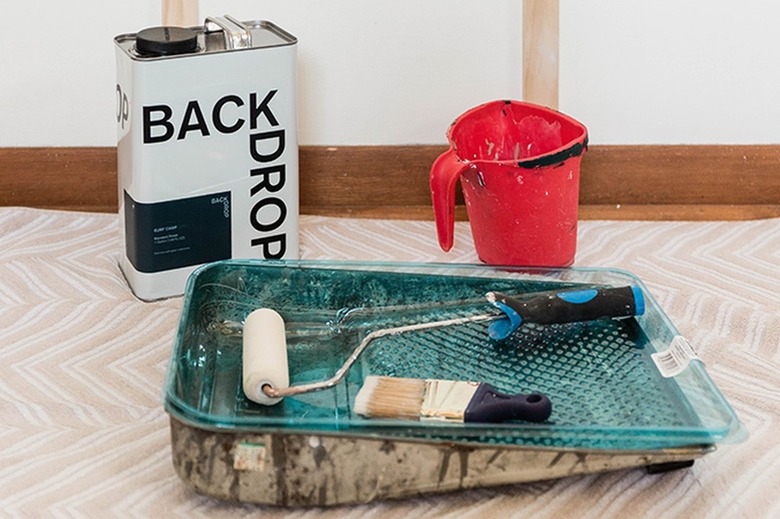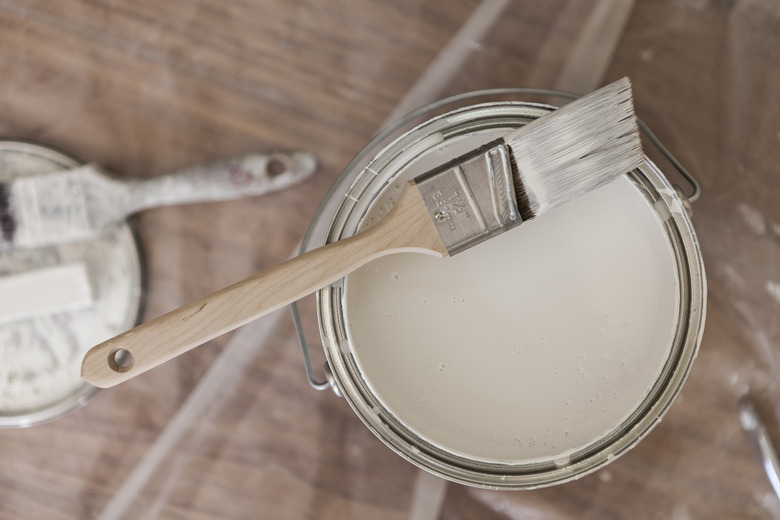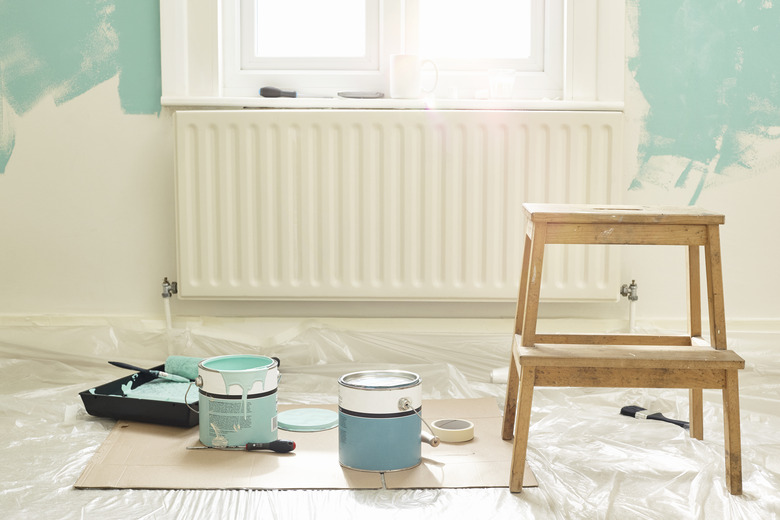Low VOC Or No VOC? Here's A Guide To Choosing A Nontoxic Paint For Your Next Project
We may receive a commission on purchases made from links.
There's nothing like a freshly painted room — except for the fumes, which could potentially be quite harmful to your health. In the last few decades, scientists have only started to understand the negative health effects that may be associated with certain types of volatile organic compounds, or VOCs, which often emit from paints, stains and varnishes. The paint industry, however, has taken note and has begun introducing low-VOC paints and even zero-VOC paints to provide shoppers with safer alternatives for their homes.
Unfortunately, these labels are often a bit confusing to the average home painter, especially when you learn that the labels are often applied to base paints, but the colorants used to modify the paint hues often have plenty of VOCs themselves — meaning your zero-VOC acrylic ceiling paint could release dangerous chemicals into your home if you add a tint to it at the paint store.
What Are VOCs?
What Are VOCs?
Volatile organic compounds are gas emissions from certain materials, including paints, stains and varnishes. These chemicals are released all the time — while the product is being stored, as the paint is being applied and even years after the paint dries as it continues to off-gas. That famous "new paint smell" is actually just a high concentration of VOCs (though it's important to note that the absence of a smell doesn't necessarily mean an absence of VOCs).
VOC levels are highest in indoor areas where chemicals get trapped inside. In fact, the Environmental Protection Agency (EPA) reports that VOCs can dramatically impact indoor air quality, and many organic chemicals are found indoors at a rate that is two to five times higher than outdoors. After activities like paint stripping are completed, the rate skyrockets to as high as 1,000 times what it is outdoors.
On a more global level, VOCs are also bad for the planet's health, as these pollutants contribute to the creation of smog, which negatively affects the air quality for everyone. This is also why you should not just choose interior paint that is low in VOCs to reduce exposure to chemicals in your home; always choose a low-VOC exterior paint even if the chemicals won't be trapped in your home.
Danger to Your Health
Danger to Your Health
There are many VOCs used in paints, including formaldehyde, benzene, toluene, acetone and other harmful chemicals. (Lead is a notably dangerous VOC, but fortunately, the EPA banned its use in most paints back in 1978.) The effects of these chemicals vary, and some have only short-term effects, while others have more serious long-term effects.
Some of the most common short-term health effects associated with the off-gassing of VOCs in paint include headache, fatigue, coughing, difficulty breathing, a burning feeling in the eyes, nausea and increased frequency of asthma attacks. Symptoms will increase with longer or more frequent exposure and, of course, from higher concentrations of VOCs. Long-term exposure to VOCs can even result in central nervous system disorders, cancer and damage to the kidneys or liver.
With all that in mind, it's easy to see why so many families are increasingly turning to more eco-friendly, nontoxic paint options, especially when you learn that paint is actually one of the largest sources of VOCs. For a really eco-friendly paint, look for a Greenguard gold certification or a Green Seal label on any products you choose. These are both well-respected indicators of paint safety and are awarded to only relatively eco-friendly products with low VOC levels.
What Are Low-VOC Paints?
What Are Low-VOC Paints?
As you may guess, low-VOC paints are supposed to have lower levels of VOCs than traditional paints. However, like many things you see on product labels (think "healthy" or "low sugar"), there is not actually a set legal standard when it comes to labeling a paint as "low VOC." This is why it's important to look at the actual VOC numbers on the label. Generally, matte low-VOC paints should have less than 50 grams of VOC per liter (indicated as 50 g/l), while semigloss and high-gloss paints should have VOC levels below 100 g/l. That's because paints with shinier finishes tend to have higher VOC levels because they contain more solvents and other toxic chemicals.
Unfortunately, the whole mess becomes even more confusing when you consider that these numbers often involve only the base paint hues, but many pigments contain high levels of VOCs, which typically add between 5 and 20 grams of VOCs per ounce back into your paint. Darker colorants, which contain more VOCs, can even add up to 300 grams per gallon. (This makes that classic eggshell white suddenly seem a lot more appealing, right?) But don't worry if you're a fan of the brooding, dark tones — there are low-VOC paint tints available in every shade. Just make sure you speak up when getting your color customized to ensure you're getting nontoxic pigments or just stick with an off-the-shelf color.
When it comes to high-quality, low-VOC paints, a few good options include Valspar Signature Semi-Gloss, which has Greenguard certification for low emissions and a drying time of only one hour for the first coat, Rust-Oleum Ultra Matte Interior Chalked, which is a popular paint for furniture and Kilz Tribute Matte Paint and Primer in One, which is also Greenguard certified and is sold premixed in 26 colors and four finishes.
What About Zero-VOC Paints?
What About Zero-VOC Paints?
As for zero-VOC paints, you might be surprised to learn that they don't actually need to be 100 percent VOC-free to be labeled as such; they just have to meet zero-emissions standards, meaning they test under 5 g/l. When buying a no-VOC paint, don't be tempted to tint your color at the paint counter of your local retailer because then you may be adding harmful VOCs to your zero-VOC paint. Stick with pretinted hues that were specially developed by the paint company. At the very least, make sure you only have low-VOC colorants added at the paint store to get your desired hue, leaving you with an overall low-VOC colored paint.
When it comes to zero-VOC paint brands, keep an eye out for ECOS Paint, which includes a detailed list of ingredients and VOC test information on each paint can, or AFM Safecoat, which was developed with the help of physicians to limit exposure to VOCs. Other quality options include Clare Paint, Sherwin-Williams Harmony and Benjamin Moore Eco Spec.
Are Low-VOC Paints as Good?
Are Low-VOC Paints as Good?
There was a time when even low-VOC paints were rare and had a bad reputation for being incredibly expensive, providing poor coverage and having less durability than traditional paints. However, as these eco-friendly alternatives have become mainstream, quality has gone up, and the price has gone down. That being said, if you're covering a dark wall with a lighter color of these paints, some of these paints will require up to two additional coats of paint compared to a high-VOC paint, so look for something with a built-in primer to speed things up if you're trying to lighten a dark shade.
Similarly, while many of these products dry slower than other paints, that's not always the case. In fact, one of the selling points of AFM Safecoat is that it dries quickly to minimize chemical exposure for those who are sensitive to paint fumes. (Remember that even zero-VOC paints may contain a small level of VOCs, especially when colorants are added.)
Entirely VOC-Free Paints
Entirely VOC-Free Paints
Some people dislike the fact that even zero-VOC paint can actually still contain a small number of VOCs. For a truly VOC-free option, there's always milk paint, which is made from the casein found in milk along with lime and borax. On the downside, most of these products are sold as a powder, requiring you to add water and mix the paint yourself with a blender or a drill fitted with a mixing attachment. While there are many versions available, Real Milk Paint is a good option that is sold premixed and comes in 56 colors using 100 percent organic ingredients. Another good choice is Old Fashioned Milk Paint, which is available in 32 colors, or you can customize your own shade with its natural pigments, such as mica powder.
References
- Bob Vila: The Best Low-VOC Paint for a Safe, Stylish Project
- Better Homes & Gardens: What Are Zero-VOC Paints? 9 Brands to Add Color to Your Home Without Harmful Chemicals
- Federal Trade Commission: Before You Buy Paint
- Brad the Painter: Low VOC Paint: What are VOCs and Will They Kill Me? Yes, Yes They Will.
- Hong Kong Environmental Protection Department: Volatile Organic Compounds and Smog
- United States Environmental Protection Agency: Volatile Organic Compounds' Impact on Indoor Air Quality
- Paint & Coatings Industry: Common Sources of VOCs in the Home: How to Limit Your Exposure


